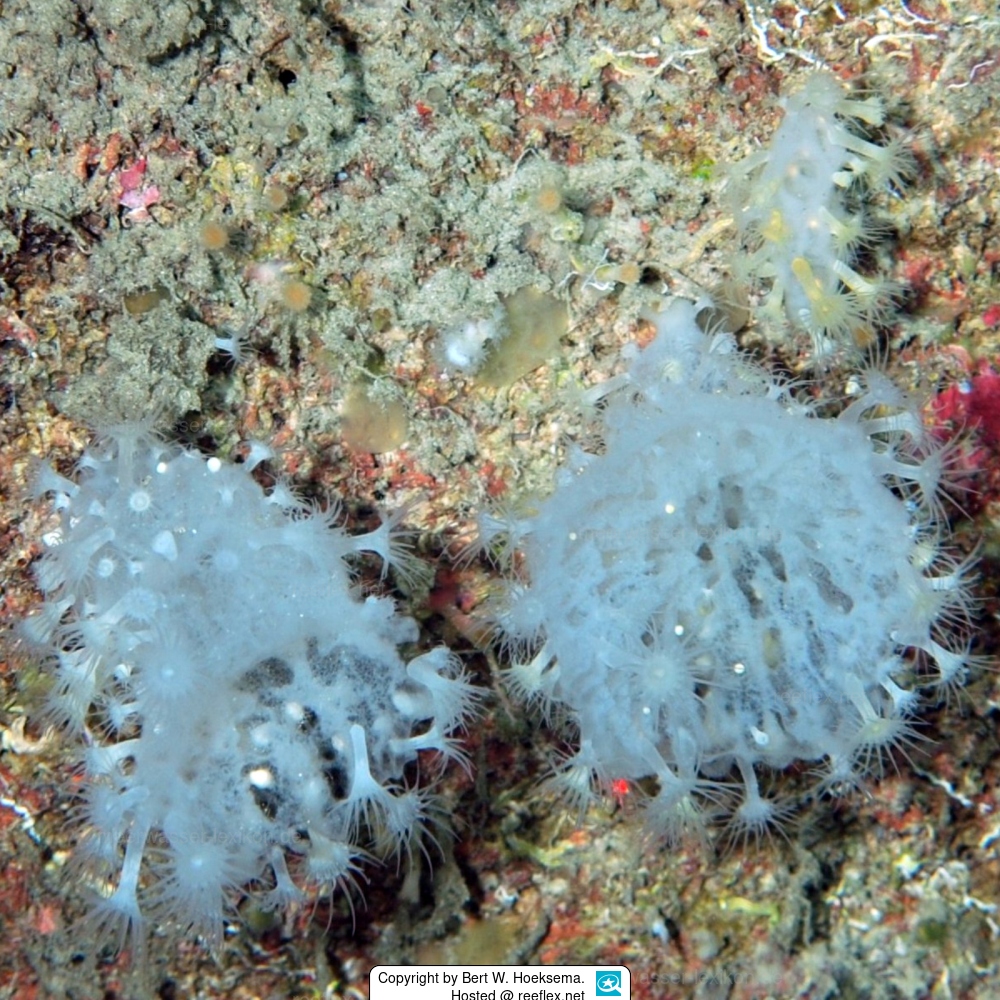Info
The deep-water crustose anemone Vitrumanthus schrieri, first described in 2022, has about 50 cylindrical polyps, single or colonial polyps protrude irregularly from the hexactinellid sponge Verrucocoeloidea liberatoriii Reswig & Dohrmann, 2014.
The living polyps are white and the tentacles are transparent in color.
The surface of the body column is rough and the ectoderm has silica particles of various sizes throughout.
The live expanded oral discs are up to 8.0 mm in diameter, and the expanded polyps are up to 10 mm in height and 1.0 - 5.0 mm in diameter. There are 20 - 24 tentacles on each polyp.
Vitrumanthus schrieri has been found associating with the following host sponges as:
Verrucocoeloidea liberatorii Reswig & Dohrmann, 2014.
Parahigginsia strongylifera Van Soest, Meesters & Becking, 2014 and.
Cyrtaulon sigsbeei ( Schmidt, 1880) .
Etymology: the species is named after Adriaan "Dutch" Schrier, owner of the manned submersible Curasub and the RV Chapman operated from the Curaçao substation, who generously allowed BWH to take specimens.
The crustose anemone does not possess zooxanthellae, but does have mesenteric filaments.
Other newly described deep-water Zoanthus species:
Vitrumanthus vanderlandi
Vitrumanthus oligomyarius
Remarks:
Vitrumanthus schrieri is associated with Verrucocoeloidea sponges.
Vitrumanthus schrieri is not only associated with hexactinellid sponges, but also with Demospongiae species of the genus Parahigginsia.
Vitrumanthus vanderlandi and Vitrumanthus oligomyarius associated with the sponge Tretochone duplicata.
In addition, the column of Vitrumanthus schrieri is rough due to heavy encrustation, while the columns of Vitrumanthus vanderlandi and Vitrumanthus oligomyarius are smooth with almost no encrustation.
Vitrumanthus vanderlandi is associated with Cyrtaulon species.
The living polyps are white and the tentacles are transparent in color.
The surface of the body column is rough and the ectoderm has silica particles of various sizes throughout.
The live expanded oral discs are up to 8.0 mm in diameter, and the expanded polyps are up to 10 mm in height and 1.0 - 5.0 mm in diameter. There are 20 - 24 tentacles on each polyp.
Vitrumanthus schrieri has been found associating with the following host sponges as:
Verrucocoeloidea liberatorii Reswig & Dohrmann, 2014.
Parahigginsia strongylifera Van Soest, Meesters & Becking, 2014 and.
Cyrtaulon sigsbeei ( Schmidt, 1880) .
Etymology: the species is named after Adriaan "Dutch" Schrier, owner of the manned submersible Curasub and the RV Chapman operated from the Curaçao substation, who generously allowed BWH to take specimens.
The crustose anemone does not possess zooxanthellae, but does have mesenteric filaments.
Other newly described deep-water Zoanthus species:
Vitrumanthus vanderlandi
Vitrumanthus oligomyarius
Remarks:
Vitrumanthus schrieri is associated with Verrucocoeloidea sponges.
Vitrumanthus schrieri is not only associated with hexactinellid sponges, but also with Demospongiae species of the genus Parahigginsia.
Vitrumanthus vanderlandi and Vitrumanthus oligomyarius associated with the sponge Tretochone duplicata.
In addition, the column of Vitrumanthus schrieri is rough due to heavy encrustation, while the columns of Vitrumanthus vanderlandi and Vitrumanthus oligomyarius are smooth with almost no encrustation.
Vitrumanthus vanderlandi is associated with Cyrtaulon species.







 Prof. Dr. Bert W. Hoeksema, Holland
Prof. Dr. Bert W. Hoeksema, Holland




